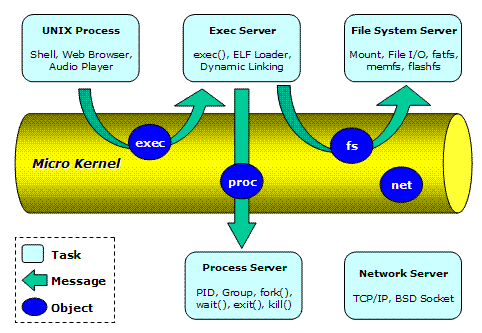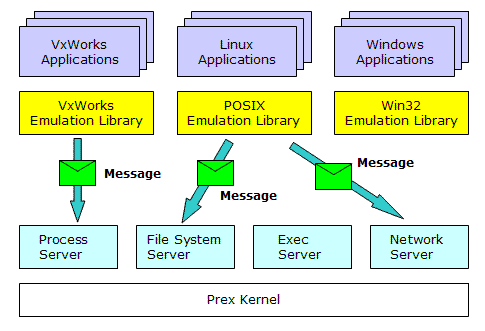|
|||
| Prex Home > Document Index > Technology Overview | |||
Prex Technology OverviewVersion 1.1, 2005/09/01Table of ContentsPrex ComponentsThe following figure illustrates the Prex components.  Figure 1. Prex Components The Prex microkernel provides only fundamental functions to abstract a processor and minimum hardware. In addition, it provides some real-time support functions for a real-time task. The microkernel also provides standard kernel services for the device drivers. There exists a strict interface for the thin layer called as "Architecture Dependent Layer" in the microkernel. The other basic OS functions like process, file system, networking etc., are provided by system server tasks. There is no characteristic difference between server tasks and normal tasks. The tasks will communicate with other by using IPC message via a microkernel. Prex will also provide some interface emulation libraries for an application interoperability. Although the server tasks are required to run UNIX processes, a native real-time task can work without any system servers. MicrokernelThe design policies for the Prex kernel are as follows:
Device DriversPrex device drivers work in kernel mode. All device drivers are stored in one single driver module, and this is separated from the kernel module. The driver module is linked with the kernel at boot time, and all device drivers are initialized at that time. The interface between the kernel and drivers are defined clearly as "Driver Kernel Interface (DKI)". The kernel provides the following services for device drivers.
System ServersThe Prex tasks can communicate with each other by sending message to the specific object, as illustrated below.  Figure 2. Prex message passing Prex provides some standard server tasks to support generic OS functions that are removed from the kernel. The server tasks include:
A server task will create its object named like "fs", "proc", or "exec" in the kernel object name space. Each user mode task will send a message to these objects in order to use the server services. A server task can re-send the received message to another task. This mechanism can allow servers to "forward" the specific message to another server. For example, the proxy server will forward a received message to the remote proxy server via network. Emulation LibrariesPrex provides some libraries to emulate POSIX interfaces. They will include standard UNIX system calls, pthread, and real-time extension. The typical works of these libraries are to pack the application's request into a message, and send it to the appropriate server. It will encapsulate the message structure defined by each server task. For example, an application can use fork() system call as a library routine, which will automatically send the message to the process server. So, there is no need to modify the source code of the existing UNIX applications to run it on Prex.  Figure 3. OS Emulation The emulation libraries can be made not only for POSIX but also for API of other OS. This allows Prex to support the execution of various different OS applications without changing the system servers. The developers will benefit from the source level compatibility of existing applications. Boot LoaderPrex provides the OS boot loader if it is required on the target platform. The boot loader will support the following minimum functions:
Since the boot mechanism depends on the hardware of each system,
its design is not strictly defined. |
|||
|
Copyright© 2005-2007 Kohsuke Ohtani |
|||
